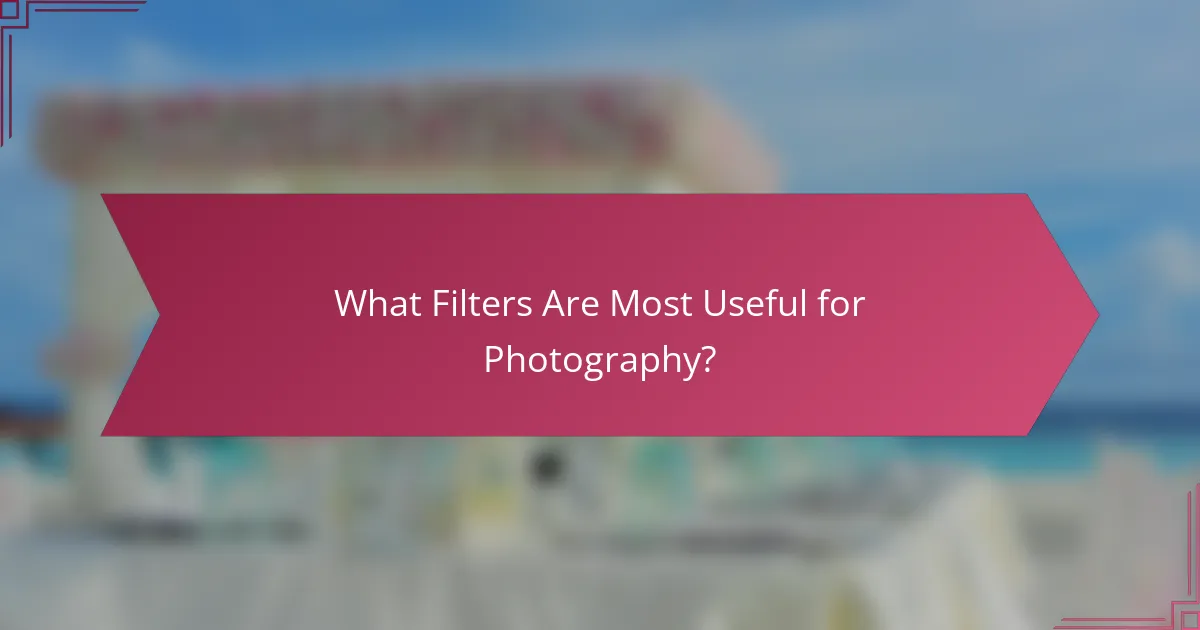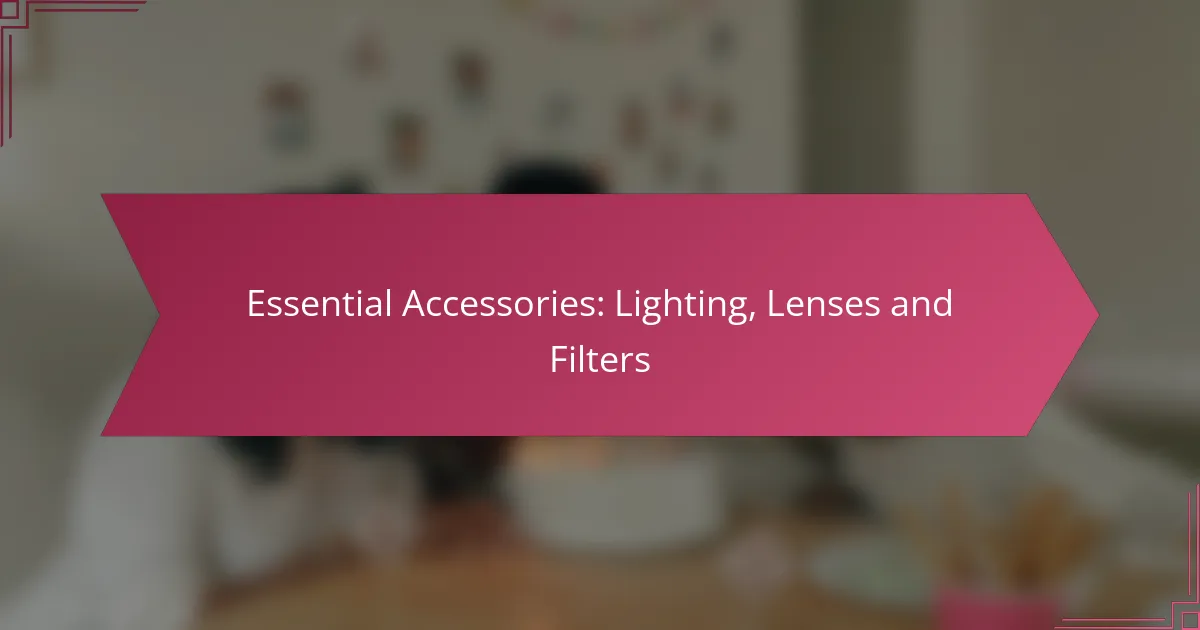Essential accessories such as lighting, lenses, and filters play a vital role in enhancing photography and videography. Proper lighting ensures optimal illumination for various settings, while the right lenses are crucial for achieving desired effects and image quality. Additionally, filters can significantly improve your images by controlling light and enhancing colors, making them indispensable tools for any photographer.

What Are the Essential Lighting Accessories?
Essential lighting accessories enhance photography and videography by providing the right illumination for various settings. Key options include LED light panels, softbox lighting kits, ring lights, continuous lighting systems, and flash units, each serving unique purposes and offering different benefits.
LED Light Panels
LED light panels are versatile lighting tools that provide even illumination and can be adjusted for brightness and color temperature. They are energy-efficient and often lightweight, making them ideal for both indoor and outdoor shoots.
When choosing LED panels, consider factors such as size, battery life, and adjustable settings. Popular options range from small portable panels to larger studio models, catering to different needs and budgets.
Softbox Lighting Kits
Softbox lighting kits diffuse light to create a soft, even glow, reducing harsh shadows and enhancing skin tones. They are commonly used in portrait photography and video production to achieve a professional look.
When selecting a softbox kit, pay attention to the size and shape of the softbox, as these factors influence the light spread. Kits typically include stands and bulbs, and prices can vary widely based on quality and brand.
Ring Lights
Ring lights provide a unique, circular light source that creates even illumination and catchlights in the subject’s eyes. They are particularly popular among beauty and makeup artists for close-up shots and tutorials.
Look for adjustable brightness and color temperature settings when purchasing a ring light. Many models are compatible with cameras and smartphones, making them versatile for various applications.
Continuous Lighting Systems
Continuous lighting systems offer a constant light source, allowing photographers and videographers to see how the light affects their subject in real-time. This type of lighting is beneficial for both stills and video work.
Consider the type of bulbs used, as options like fluorescent and LED can affect color accuracy and heat output. Continuous lighting systems can range from affordable kits to more professional setups, depending on your needs.
Flash Units
Flash units provide powerful bursts of light, ideal for freezing motion and enhancing exposure in challenging lighting conditions. They are commonly used in portrait photography and events to achieve well-lit images.
When selecting a flash unit, consider its guide number, which indicates its power, and whether it has features like TTL (Through The Lens) metering for automatic exposure. Prices can vary significantly based on brand and capabilities, so assess your specific requirements before purchasing.

How to Choose the Right Lenses?
Choosing the right lenses is crucial for achieving the desired photographic effect and quality. Consider factors such as focal length, aperture, and the type of photography you intend to pursue.
Prime Lenses
Prime lenses have a fixed focal length, meaning they do not zoom. They typically offer wider apertures, allowing for better low-light performance and a shallower depth of field, which is ideal for portraits and creative shots.
When selecting a prime lens, consider the focal length that suits your style. Common options include 35mm for street photography and 50mm for portraits. These lenses often provide superior image quality compared to zoom lenses.
Zoom Lenses
Zoom lenses provide versatility by allowing you to change the focal length without changing the lens. They are ideal for situations where you need to quickly adapt to different subjects, such as events or wildlife photography.
However, zoom lenses often have smaller maximum apertures, which can limit low-light performance. Look for options with a constant aperture for better control over exposure, especially in changing light conditions.
Wide-Angle Lenses
Wide-angle lenses have shorter focal lengths, typically ranging from 14mm to 35mm. They are perfect for landscape, architecture, and interior photography, as they capture a broader field of view.
When using wide-angle lenses, be mindful of distortion, especially at the edges of the frame. Consider using a lens with low distortion characteristics if you want to maintain straight lines in architectural shots.
Telephoto Lenses
Telephoto lenses have longer focal lengths, usually from 70mm to 300mm or more. They are excellent for capturing distant subjects, making them a favorite for wildlife and sports photography.
Keep in mind that telephoto lenses can be heavier and may require stabilization features to avoid camera shake. A lens with a wide aperture can also help achieve a shallow depth of field, isolating subjects effectively.

What Filters Are Most Useful for Photography?
Filters are essential tools in photography that enhance image quality and control light. The most useful filters include polarizing, neutral density, UV, and graduated filters, each serving distinct purposes to improve your photographic results.
Polarizing Filters
Polarizing filters reduce glare and reflections from surfaces like water and glass, enhancing color saturation and contrast in images. They are particularly beneficial for landscape photography, where they can make skies appear bluer and foliage more vibrant.
When using a polarizing filter, rotate it to find the optimal angle for glare reduction. It’s important to note that these filters can reduce light entering the lens by about 1.5 to 2 stops, so adjust your exposure settings accordingly.
Neutral Density Filters
Neutral density (ND) filters decrease the amount of light entering the lens without affecting color balance, allowing for longer exposure times or wider apertures in bright conditions. This is ideal for creating motion blur in waterfalls or smoothing out the surface of water.
ND filters come in various strengths, typically measured in stops (e.g., 3-stop, 6-stop). Choose a filter based on your shooting conditions; for example, a 10-stop ND filter is great for bright daylight but may be excessive for overcast days.
UV Filters
UV filters were originally designed to block ultraviolet light, which can cause haziness in images. While modern cameras are less affected by UV light, these filters still serve as a protective layer for your lens against scratches and dust.
When using UV filters, ensure they are of high quality to avoid introducing unwanted lens flare or distortion. They are particularly useful for outdoor photography, where lens protection is crucial.
Graduated Filters
Graduated filters transition from clear to tinted, allowing photographers to balance exposure between a bright sky and a darker foreground. They are especially useful in landscape photography to prevent overexposed skies while maintaining detail in the land below.
When selecting graduated filters, consider the transition type—soft or hard—and the color tint that best suits your scene. Proper alignment is key; position the filter so the transition line matches the horizon for a natural look.

What Are the Key Considerations for Selecting Accessories?
Selecting accessories for photography involves evaluating compatibility, budget, and intended use. These factors ensure that the accessories enhance your photography experience without causing frustration or overspending.
Compatibility with Camera Models
When choosing accessories, ensure they are compatible with your specific camera model. Different brands and models may have unique fittings and specifications, so check the manufacturer’s guidelines or user reviews for compatibility information.
For instance, lens mounts vary between brands like Canon, Nikon, and Sony. Using an incompatible lens can lead to poor performance or even damage to your camera.
Budget Constraints
Establishing a budget is crucial when selecting photography accessories. Prices can range significantly, from affordable filters and basic lenses to high-end lighting equipment that costs hundreds or even thousands of dollars.
Consider prioritizing essential accessories first. For example, investing in a good quality tripod or a versatile lens can provide more value than multiple lower-quality items.
Intended Use Cases
Your intended use will greatly influence the type of accessories you need. For instance, if you plan to shoot in low-light conditions, investing in a fast lens or a reliable light source is essential.
Additionally, if you focus on landscape photography, a polarizing filter can enhance colors and reduce glare. Understanding your specific needs will help you make informed decisions about which accessories to invest in.

How Do Lighting, Lenses, and Filters Work Together?
Lighting, lenses, and filters are essential components that collectively enhance photography by controlling exposure, focus, and color. Understanding how these elements interact can significantly improve image quality and creativity in photography.
Enhancing Image Quality
Lighting is crucial for capturing high-quality images, as it affects exposure and mood. Natural light, artificial light, and the direction of light can create different effects, so consider the time of day and weather conditions when shooting. For instance, golden hour light provides a warm tone, while harsh midday sun can create unflattering shadows.
Lenses play a vital role in determining the sharpness and depth of field in your images. Different lenses, such as wide-angle or telephoto, offer unique perspectives and compositions. When selecting a lens, consider its aperture size, which influences how much light enters and the ability to blur backgrounds, enhancing the subject’s focus.
Filters can modify the light entering the lens, allowing for greater control over the final image. Polarizing filters reduce glare and enhance colors, while neutral density filters enable longer exposures in bright conditions. When using filters, ensure they are compatible with your lens size and consider stacking them carefully to avoid vignetting.
